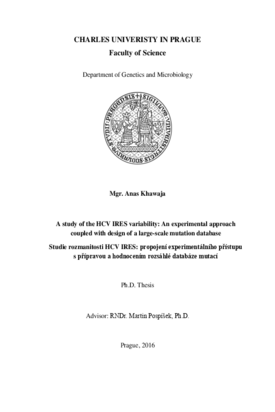A study of the HCV IRES variability: An experimental approach coupled with design of a large-scale mutation database
Studie rozmanitosti HCV IRES: propojení experimentálního přístupu s přípravou a hodnocením rozsáhlé databáze mutací
dissertation thesis (DEFENDED)

View/
Permanent link
http://hdl.handle.net/20.500.11956/81828Identifiers
Study Information System: 112899
Collections
- Kvalifikační práce [20352]
Author
Advisor
Referee
Hirsch, Ivan
Valášek, Leoš
Faculty / Institute
Faculty of Science
Discipline
-
Department
Department of Genetics and Microbiology
Date of defense
27. 9. 2016
Publisher
Univerzita Karlova, Přírodovědecká fakultaLanguage
English
Grade
Pass
Keywords (Czech)
HCV, IRES, mutace, variabilita, databáze, účinnost translace, struktura, kvazidruhy, codon bias, coreKeywords (English)
HCV, IRES, mutation, variability, database, translation efficiency, structure, quasispecies, codon bias, coreIniciace translace u viru hepatitidy C (HCV) probíhá mechanismem nezávislým na čepičce, který využívá vnitřního vazebného místo pro ribozom (IRES), které interaguje s eukaryotním translačním aparátem a je schopné jej využívat. V našem výzkumu jsme se zaměřili na strukturní konformaci jednotlivých domén HCV-IRES a na dopad primární sekvence IRES na konzervovanost a funkci této sekundární struktury. Za tímto účelem byl proveden screening pacientů infikovaných virem hepatitidy C pro zjištění míry heterogenity a celkové variability HCV-IRES vzniklé u pacientů v průběhu jejich nemoci pomocí optimalizování metod, jako jsou gelové elektroforézy s denaturačním nebo teplotním gradientem. Účinnost translace mutovaných HCV-IRES sekvencí byla měřena pomocí průtokové cytometrie. V některých případech jsme zjistili, že několikanásobné mutace, včetně těch, které jsou rozesety mezi různé domény HCV-IRES, vedly k obnově translační aktivity, ačkoli tyto mutace účinnost translace snižovaly, pokud byly analyzovány jednotlivě. Navrhujeme, že tato pozorování by mohla být vysvětlena potenciálními mezi- a/nebo vnitro-doménovými funkčními interakcemi působícími na velkou vzdálenost. Také jsme nalezli nové mutace, jejichž vliv na účinnost translace HCV-IRES byl experimentálně ověřen. Vytvoření rozsáhlé databáze variací...
Translation initiation in the hepatitis C virus (HCV) occurs through a cap- independent mechanism that involves an internal ribosome entry site (IRES) capable of interaction with and utilization of the eukaryotic translational machinery. We focused on the structural configuration of the different HCV-IRES domains and the impact of IRES primary sequence variations on secondary structure conservation and function. For this purpose we introduced into our laboratory, methods such as denaturing gradient and temperature gradient gel electrophoresis for screening the degree of heterogeneity and total amount of HCV-IRES variability accumulated in HCV infected patients over a period of time. The selected samples showed variable migration pattern of the HCV-IRES (from all the patients) visualized in DGGE and TGGE, were sequenced and evaluated for translation efficiency using flow cytometry. In some cases, we discovered that multiple mutations, even those scattered across different domains of HCV-IRES, led to restoration of the HCV-IRES translational activity, although the individual occurrences of these mutations were found to be deleterious. We propose that such observation may be attributed to probable long- range inter- and/or intra-domain functional interactions. We established a large-scale HCV-IRES...
